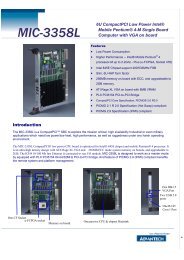industrial wireless book special edition - Networking ...
industrial wireless book special edition - Networking ...
industrial wireless book special edition - Networking ...
You also want an ePaper? Increase the reach of your titles
YUMPU automatically turns print PDFs into web optimized ePapers that Google loves.
Glossary<br />
• DSSS – Direct Sequence Spread Spectrum. This is a method of encoding a signal which distributes<br />
information over a wide path of spectrum using a pseudo random code. Because of the wide spreading,<br />
the signal appears to be noise for those without the spreading code.<br />
• FHSS – Frequency Hopping Spread Spectrum. Similar to DSSS, the big difference is that is uses a<br />
more constrained spreading algorithm and changes channels as a function of time, theoretically making<br />
the transmission more immune to interference.<br />
• TSMP – Time Synchronized Mesh Protocol. This is a mesh protocol that uses time slots to allocate<br />
spectrum for communication between two nodes. Because time slots differ over pairs, interference<br />
is minimized because access to the channel is controlled by timeslot.<br />
• Cluster Tree – Region based mesh network routing algorithm. In this algorithm, routes are formed<br />
and maintained between clusters of nodes. Route discovery is completed and maintained between<br />
the clusters – providing access to the children of each cluster.<br />
• PAN ID – Personal Area Network Identifier. This is the term for the network name assigned to particular<br />
personal area network.<br />
• CSMA – Carrier Sense Multiple Access. This protocol defines the channel access technique deployed<br />
by Ethernet, Wi-Fi and bus oriented networks. It provides a method for detecting collisions and<br />
retransmitting as a method to acquire a communications channel.<br />
• TDMA – Time Division Multiple Access. The protocol defines the channel access technique used<br />
by TSMP and GSM networks in which a communications channel is divided into time slots. Each node<br />
is allocated a specific time slot for communication.<br />
volume of data. Data flow can be placed in<br />
three categories: dribble data, burst data and<br />
streaming data. Dribble data is periodic,<br />
infrequent and slow, while streaming data is<br />
constant, etc. A network can be large if the<br />
traffic is dribble data because the flow follows<br />
consistent patterns, with plenty of bandwidth.<br />
Sleeping networks do well with dribble data,<br />
but scale poorly with streaming data.<br />
Data Movement is about raw carrying<br />
capacity and the classic trade off: Does the<br />
application require lots of data with low latency<br />
or does it require dribble data with long, non<br />
deterministic latency? This can be resolved to<br />
five variables, namely data rate, latency, packet<br />
size, fragmentation, and range.<br />
Cost is measured by the unit cost per node<br />
as well as the cost to maintain the network. It<br />
becomes more complicated in the case of<br />
battery powered sleeping nodes. As one might<br />
expect the combined unit and maintenance<br />
cost of <strong>wireless</strong> mesh networks tends to be<br />
evaluated relative to the cost of the devices<br />
served.<br />
Network architectures<br />
Point to multipoint<br />
Key Characteristics. Mostly a simple star, it is<br />
often confused with a mesh network. These<br />
networks, of which Bluetooth is the prime<br />
example, tend to use either FHSS or DSSS<br />
(802.15.4) air interfaces. They require static<br />
configuration for PAN ID, routes, and security.<br />
All nodes can see all other nodes and need to<br />
be told which nodes to talk to. Security tends<br />
to be pair-wise for both the encryption and<br />
key. End points may go to sleep or stay awake,<br />
but the central router is always awake.<br />
Network Architecture. All nodes are on the<br />
same channel (or hop to the same channel).<br />
Bandwidth/throughput limited by simultaneous<br />
data at the concentration point. Figure 3 illustrates<br />
a typical topology. Collisions happen<br />
with lots of traffic or lots of nodes.<br />
Fig. 3. Point to multipoint<br />
network. Mostly a simple<br />
star, it is often confused with<br />
a mesh network. Bluetooth is<br />
a prime example of the<br />
network type<br />
Strengths. The beauty of the basic non-mesh<br />
point to multipoint network is simplicity.<br />
Communication, unless traffic is very heavy, is<br />
relatively deterministic since there are no hops<br />
and minimal, or managed, collisions. It also<br />
allows for maximum throughput because there<br />
is no added routing or route discovery. Finally<br />
it is easy to understand and easy to manage.<br />
Because of the simplicity, it also tends to drive<br />
the lowest cost for its specific size and function.<br />
Limitations. Unfortunately, the simplicity<br />
provokes limitations. Networks tend to be<br />
small. Large networks only work if polled from<br />
central point. This requires very specific<br />
message management. There are also single<br />
points of failure and no ways to route around<br />
changing conditions. The network follows the<br />
belief that if it worked the first time, it will<br />
work forever – which it will if RF environmental<br />
conditions are maintained.<br />
ZigBee 2007<br />
Key Characteristics. ZigBee is built on top of<br />
802.15.4 using DSSS at 2.4GHz. End points<br />
sleep, routers don’t sleep and a coordinator is<br />
needed to start the network and to allow points<br />
to join the network.<br />
sponsored by Advantech<br />
<strong>industrial</strong> ethernet <strong>book</strong>

















